Sold Ceramics
Sold Chine de commande
Western Subjects 1680-1800
Mythological and Religious Subjects
Page 1
In the Sold Ceramics - Sold Chine de commande - Western Subjects 1680-1800 - Mythological & Religious Subjects category the sold objects are categorized in the following alphabetical order:
- Mythological Subjects
- Religious Subjects
Sold Mythological Subjects
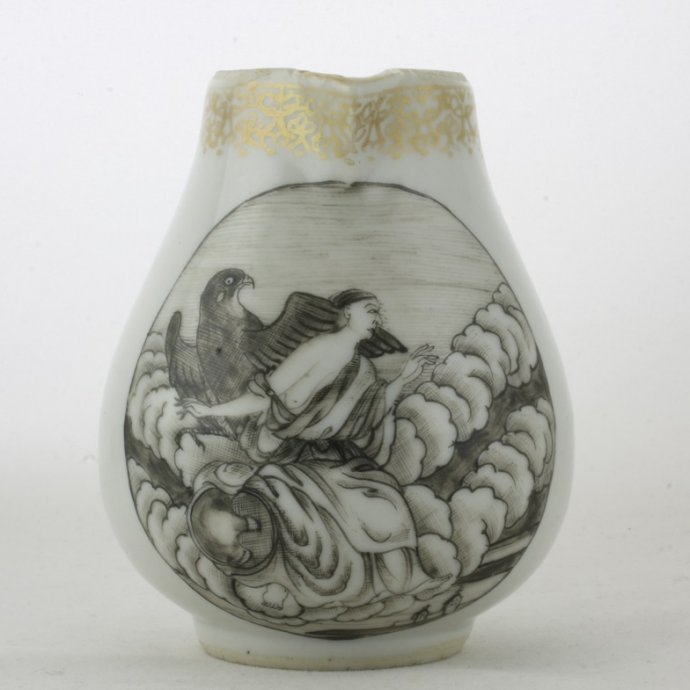
Sold Ceramics - Sold Chine de commande - Westeren Subjects 1680-1800 - Mythological and Religious Subjects - Mythological Subjects - Page 1
Object 2011474
Milk jug
China
c.1740
Height 88 mm (3.46 inch), diameter 74 mm (2.91 inch), diameter of mouthrim 35 mm (1.38 inch), diameter of footring: 35 mm (1.38 inch), weight 146 grams (5.15 ounce (oz.))
Milk jug on footring, a pear shaped body with handle, a small triangular spout at the rim. The base is glazed. The handle is placed opposite the spout. The rim is unglazed inside for a cover, now missing. Decorated in "en grisaille / encre de Chine" and gold with a rare mythological scene, namely Zeus or Jupiter borne on a throne of billowing clouds above a landscape, his companion eagle at his side. Round the rim a formalized foliate scroll border.
Subjects from Greek and Roman mythology were prevalent and enjoyed great popularity, not least because it was such a good pretext to depict beautiful, half-naked women, disguised as goddesses or nymphs from classical antiquity. The fashion suddenly came into being around 1735, had its heyday in the middle of the century and faded away after the 1760's. As with the Chine de commande with religious themes, tea wares, plates and dishes with mythological designs are abundant while other dinner wares are lacking. Probably they were more appreciated as decorative items and to a lesser extent, useful as table wares. (Jörg 1989/2)
A far more common design of Zeus on Chinese export porcelain is that after an engraving of Claude Audran III (1658-1734). It forms part of a series depicting various Olympian gods and goddesses, Les Douze Mois Grotesques, done by Audran for the Gobelins factory in 1708-09.
For two examples, please see:
- Chinese Export Porcelain in the Reeves Center Collection at Washington and Lee University, (Th. V. Litzenburg, London 2003), p.190, cat. 187.
- La porcelaine des Compagnies des Indes a décor Occidental, (F. & N. Hervouët & Y. Bruneau, Flammarion - Pere Castor, Paris 1986), p.292, no. 13.1 & 13.2.
Another well known depiction on Chine de commande porcelain after the same series of engravings by Audran is that of Jupiters spouse Juno/Hera, please see my sold objects 2010375, 2010628 and 2010901.
However, this particular design of Zeus is very rare and hardly documented. For two octagonal dishes with identical mythological scene, please see:
- Fine Chinese Export Porcelain from the Collection of Angelo Castelo Branco Cerqueira Caldas, auction sale catalogue Sotheby's London, 8th May 1990, pp.106-107, lot 220.
- La porcelaine des Compagnies des Indes a décor Occidental, (F. & N. Hervouët, Y. Bruneau, Flammarion - Pere Castor, Paris 1986), p.292, no. 13.2.
Interestingly, the border design of a golden band of fruit and flowers on these dishes is different from the one on this milk jug, although both are clearly inspired by German Meissen porcelain. The elaborate and finely painted golden scrollwork decoration on the rim was common in the Meissen Porcelain Factory from 1720 until about 1740. It can also be found on a series of armorial dishes en grisaille and gold and plates with Chinoiserie designs based on Meissen originals. (Howard 1994, p.82), (Fuchs & Howard 2005, p.67)
Condition: A firing flaw and a short hairline to the rim.
References:
Hervouët 1986, no. 13.1 & 13.2
Price: Sold.

Sold Ceramics - Sold Chine de commande - Western Subjects 1680-1800 - Mythological and Religious Subjects - Mythological Subjects - Page 1
Object 2010672
Teapot stand
China
c.1750
Height 17 mm (0.67 inch), dimensions 120 mm (4.72 inch) x 133 mm (5.24 inch)
Hexagonal teapot stand or saucer dish with spreading upright sides, a deeply scalloped rim and a flat unglazed base with adhering kiln sand. Used as teapot or milk jug stand. Polychrome decorated in various overglaze enamels with a mythological subject. Acis and Galatea sitting under a tree being spied on by the jealous Sicilian Cyclops Polyphème sitting on a nearby rock.
In Ovid's Metamorphoses, Acis was the sprit of the Acis River in Sicily, beloved of the nereid, or sea-nymph, Galatea (she who is milk-white), daughther of Nereus and Doris. She returned his love, but a jealous rival, the Sicilian Cyclops Polyphemys, killed him with a boulder. Galatea then turned his blood into the Sicilian river Acis. (Wikipedia.org)
As early as 1728 the Dutch East India Company, (Vereenigde Oost-Indische Compagnie, VOC), "Dagh-registers" state that its ship "Coxhorn" that left Amsterdam in 1728 with destination China, returned to the Netherlands on June 13th 1730, fully loaded with tea and porcelain, among its cargo were, for instance, 810 tea pots, 251 pairs of small covered sugar-boxes and 600 pattipans. A pattipan was used to protect the surface of luxurious lacquer or painted tea tables, against the influence of a hot teapot or drops running from its spout. If, in certain circles, a special tea table was not at hand it served to protect the furniture or its valuable table-cloth from tea spots. The Dutch word "pattipan" is most likely derived from the English word "patty pan" meaning a pastry mould for little pies or pastries. These "patty pans" were very similar, in shape and size, to our "pattipannen". (Volker 1959), (Kleyn 1980, pp. 253-261)
For an identically decorated dish, please see:
- The Ceramic Art of China and other Countries of the Far East, (W.B. Honey, Faber & Faber Limited, London 1944), Plate 139
- La porcelaine des Compagnies des Indes a décor Occidental, (F. & N. Hervouët & Y. Bruneau, Flammarion - Pere Castor, Paris 1986), p.308, cat. 13.64b.
Condition: A restored hole in the centre and chip to the rim.
References:
Price: Sold.
The designs below derived from a series of prints by Claude III Audran (1658-1734) representing the months of the year. Engravings from this series were also used for decorating Chine de commande objects as can be seen on the following objects.
Suite de douze tapisseries d'epoque Louis XV 'Les douze mois Grotesques' manufacture de gobelins, vers 1726 d'apre les dessins de Claude Audran Le Jeaune, Antoine Watteau et Alex Francois Desportes (source: christies.com) (not included in this sale)

Sold Ceramics - Sold Chine de commande - Westeren Subjects 1680-1800 - Mythological and Religious Subjects - Mythological Subjects - Page 1
Object 2011769
Milk jug
China
1750-1760
Height 91 mm (3.58 inch), diameter of mouthrim 33 mm (1.30 inch), diameter of footring 33 mm (1.30 inch), weight 136 grams (4.80 ounce (oz.))
Milk jug on footring, pear shaped body with handle, small triangular spout at the rim. The handle is placed opposite the spout. The original cover is missing. Decorated in encre de Chine and gold with 'Ceres' the Roman goddess of agriculture, grain crops, fertility and motherly relationships. She is wearing her classical attributes: a wheat-crown while holding a wheat spray and sickle. On the rim a border of floral festoons, cornucopia (in Latin also cornu copiae or horn of plenty) and foliate-scrolls after an early 18th century laub- und bandelwerk Viennese design.
In 1722 Père d'Entrecolles reported that the Chinese were experimenting with painting in black, so far unsuccessfully. Black or schwarzlot, decoration, was also then just being developed in Europe, and in fact the German Hausmaler was putting it primarily on Chinese imported in the white, rather than on wares from the newly established Meissen factory. It must have been these hybrids that were sent back to Canton for imitation at the time of Père d'Entrecolle's letter, but the perfection of the technique and its translation into commercial export porcelain came only later, under the direct influence of the Du Paquier period (1719-1744).
Also unique to the Viennese Du Paquier porcelain factory was the laub- und bandelwerk border, based on two series of engravings by Paul Decker (d.1713). Continually modified and varied its essential elements were strapwork, palmettes, trelliswork cartouches, and foliate scrolls combined into a rhythmical pattern of baroque formality. Other China trade versions of the laub- und bandelwerk border, such as the more usual one with the addition of peacock and with panels of quilting rather than trellis- or scale work, are farther removed from their Viennese factory prototypes, and are perhaps derived from Hausmaler variants. (Corbeiller 1974, pp.68-69)
For an identically decorated saucer, please see:
For similarly decorated objects, please see:
The name Ceres originates from the Latin word 'Cerealis' meaning "of grain" from which we derive the modern word 'cereal'. The Cerealia festival was celebrated in her honour commenced on the 12th April and was connected with the growth of corn. The Romans saw her as the counterpart of the Greek goddess Demeter. whose mythology was reinterpreted for Ceres in Roman art and literature. (talesbeyondbelief.com)
This particular design is derived from a series of prints by Claude III Audran (1658-1734) representing the months of the year, in which Ceres symbolizes August. (Hervouët 1986, p.296)
For Venus symbolzing April in this series, please see:
For Juno symbolzing June in this series, please see:
Condition: A frit to the spout and two frits with a connected hairline to the rim.
References:
Hervouët 1986, cat. 13.24, 12.25 & 13.26
Price: Sold.
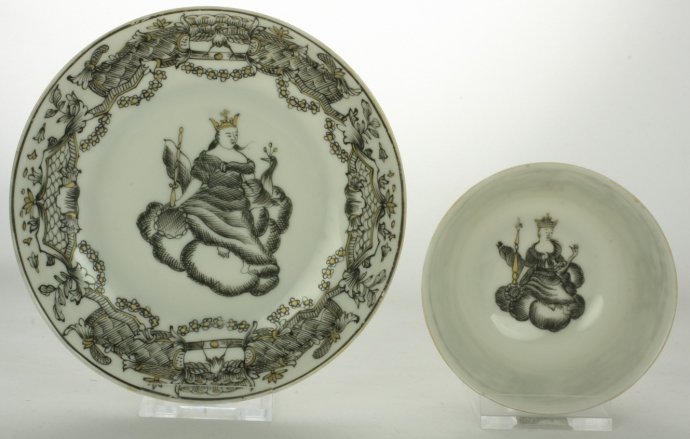
Sold Ceramics - Sold Chine de commande - Western Subjects 1680-1800 - Mythological and Religious Subjects - Mythological Subjects - Page 1
Object 2010375
Teacup and saucer
China
1750-1760
Height of teacup 39 mm (1.54 inch), diameter of rim 79 mm (3.11 inch), diameter of footring 39 mm (1.54 inch)
Height of saucer 22 mm (0.87 inch), diameter of rim 121 mm (4.76 inch), diameter of footring 75 mm (2.95 inch)
Teacup and saucer on footrings, slightly everted rims. Decorated in encre de Chine and gold with a central scene of a crowned figure seated on a cloud beside a peacock, holding a scepter and wreath. On the rim a border of peacocks and panels edged in strapwork, floral festoons and foliate-scrolls after an early 18th century laub- und bandelwerk Viennese design; the teacup is similarly decorated with the same scene on the bottom..
The Greek goddess Hera called the Queen of Heaven, was a powerful queen in her own right, long before her marriage to Zeus, the mighty king of the Olympian gods. The goddess Hera ruled over the heavens and the earth, responsible for every aspect of existence, including the seasons and the weather. She was also worshipped as the Roman goddess Juno wife of Jupiter, the month June is named in her honour. It is partly on account of Hera's great beauty, and particularly her beautiful. large eyes, that she is linked to the peacock with it's iridescent feathers having "eyes". The peacock symbolizes her luxury, beauty and immortality. The goddess Hera blessed and protected a woman's marriage, bringing her fertility, protecting her children, and helping her find financial security. Hera was, in short, a complete woman, overseeing both private and public affairs. (goddessgift.com)
The source of the design is an engraving by Claude Audran III (1658-1734) as part of a series in which various Olympian gods and goddesses depict the months of the year, Hera/Juno symbolizes June. (Hervouët 1986, p.296), (Litzenburg 2003, p.190)
In 1722 Père d'Entrecolles reported that the Chinese were experimenting with painting in black, so far unsuccessfully. Black or schwarzlot, decoration, was also then just being developed in Europe, and in fact the German Hausmaler was putting it primarily on Chinese imported in the white, rather than on wares from the newly established Meissen factory. It must have been these hybrids that were sent back to Canton for imitation at the time of Père d'Entrecolle's letter, but the perfection of the technique and its translation into commercial export porcelain came only later, under the direct influence of the Du Paquier period (1719-1744). Unique to the Viennese Du Paquier porcelain factory was the laub- und bandelwerk border, based on two series of engravings by Paul Decker (d.1713). Continually modified and varied its essential elements were strapwork, palmettes, trelliswork cartouches, and foliate scrolls combined into a rhythmical pattern of baroque formality. Other China trade versions of the laub- und bandelwerk border, such as the more usual one with the addition of peacock and with panels of quilting rather than trellis- or scale work, are farther removed from their Viennese factory prototypes, and are perhaps derived from Hausmaler variants. (Corbeiller 1974, pp.68-69)
For identically decorated objects, please see:
- De Chinese Porseleinkast, (D.F. Lunsingh Scheurleer in Mededelingenblad Nederlandse Vereniging van Vrienden van de Ceramiek, vol. 52, 1968), pp. 64-67, cat. 294.
- Aziatische Ceramiek uit vijf eeuwen, exhibition catalogue of the J.M. van Diepen Collection, (D.F. Lunsingh Scheurleer, Fraeylemaborg Slochteren, 1977), pp.72-73, cat. 199.
- Collecting Chinese Export Porcelain, (E. Gordon, Universe Books, New York, 1977), p. 63, cat 48.
- La porcelaine des Compagnies des Indes a décor Occidental, (F. & N. Hervouët & Y. Bruneau, Flammarion - Pere Castor, Paris 1986), p.293, cat. 13.5.
- Fine Chinese Export Porcelain from the Collection of Angelo Castelo Branco Cerqueira Caldas, auction sale catalogue Sotheby's London, 8th May 1990, pp.113-114, lot 233 & 235.
- The Dr Anton C.R. Dreesmann Collection, European Furniture and Chinese Export Porcelain, auction catalogue Christie's London 10 April 2002, pp.230-231, lot 443.
- Chinese Export Porcelain in the Reeves Center Collection at Washington and Lee University, (Th. V. Litzenburg, London 2003), p.190, cat. 188.
Condition:
Teacup: Perfect.
Saucer: A frit and two hairlines to the rim.
References:
Lunsingh Scheurleer 1968, cat. 294
Lunsingh Scheurleer 1977, cat. 199
Lunsingh Scheurleer 1989, cat. 215
Price: Sold.
More pictures of object 2010376 an identically decorated, sold teacup >>
More pictures of object 2010883 an identically decorated, sold sugar bowl >>
More pictures of object 2010628 an identically decorated, sold, spoon or leak tray >>
More pictures of object 2010901 an identically decorated, sold coffee cup >>
More pictures of object 2010422B an identically decorated, sold coffee cup >>
More pictures of objects 2011136ABC, three identically shaped, sized and decorated, sold saucers >>
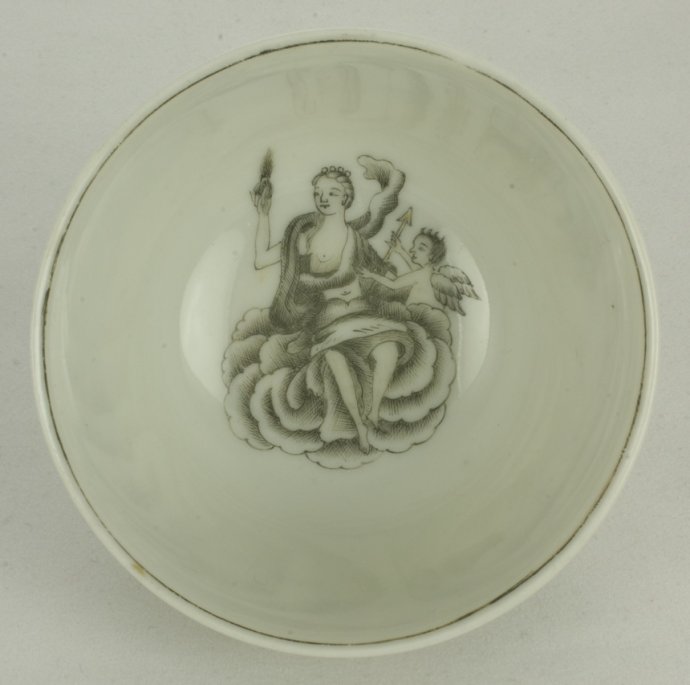
Sold Ceramics - Sold Chine de commande - Western Subjects 1680-1800 - Mythological and Religious Subjects - Mythological Subjects - Page 1
Object 2010490
Teacup
China
1740-1750
Height 40 mm (1.58 inch), diameter of rim 70 mm (2.76 inch), diameter of footring 31 mm (1.22 inch)
Teacup on a footring. Decorated in encre de Chine and gold with on the rim a laub- und bandelwerk border. On the bottom the Roman goddess of love Venus sitting on the foam of the sea with her winged boy/son Amor or Cupid who is holding a gold-headed arrow.
The design is part of a series of the months of the year engraved by Claude III Audran (1658-1734), Venus symbolizes April. Amor or Cupid is often depicted as carrying two sets of arrows: one set gold-headed, which inspire love; and the other lead-headed, which inspire hatred. (Hervouët 1986, p.296)
In 1722 Père d'Entrecolles reported that the Chinese were experimenting with painting in black, so far unsuccessfully. Black or schwarzlot, decoration, was also then just being developed in Europe, and in fact the German Hausmaler was putting it primarily on Chinese imported in the white, rather than on wares from the newly established Meissen factory. It must have been these hybrids that were sent back to Canton for imitation at the time of Père d'Entrecolle's letter, but the perfection of the technique and its translation into commercial export porcelain came only later, under the direct influence of the Du Paquier period (1719-1744). Unique to the Viennese Du Paquier porcelain factory was the laub- und bandelwerk border, based on two series of engravings by Paul Decker (d.1713). Continually modified and varied its essential elements were strapwork, palmettes, trelliswork cartouches, and foliate scrolls combined into a rhythmical pattern of baroque formality. Other China trade versions of the laub- und bandelwerk border, such as the more usual one with the addition of peacock and with panels of quilting rather than trellis- or scale work, are farther removed from their Viennese factory prototypes, and are perhaps derived from Hausmaler variants. (Corbeiller 1974, pp.68-69)
For an identically decorated teapot stand, please see:
Condition: Perfect.
References:
Corbeiller 1974, pp.68-69, cat. 30.
Price: Sold.
Sold Religious Subjects
Scenes of representations from the Bible are rather common in Chine de commande and they come in many variations mostly depicting stories from the New Testament. Although many tea wares, plates and dishes (but not apparently other dinner wares such as tureens or sauceboats) with biblical themes were produced, one may wonder if these porcelains were ever used at the tea or dinner table. Eating or drinking from Crucified Christ might well have been considered a sacrilege in the 18th century, especially in the Calvinist Netherlands. Most likely these pieces were destined for Catholic countries and used in a more or less religious context or simply had a decorative function, reminding its owner of Christian values. Formerly this type of Chine de commande, in particular pieces painted in encre de Chine, were called 'Jesuit porcelain'. However, any connection with the Jesuits in Peking or Macao or missionary activities is highly speculative and not supported by documentary evidence. Clearly Chine de commande with religious subjects was commercially ordered, just like the other types, and sold with a good profit to European customers. (Jörg 1989/2, p.160)
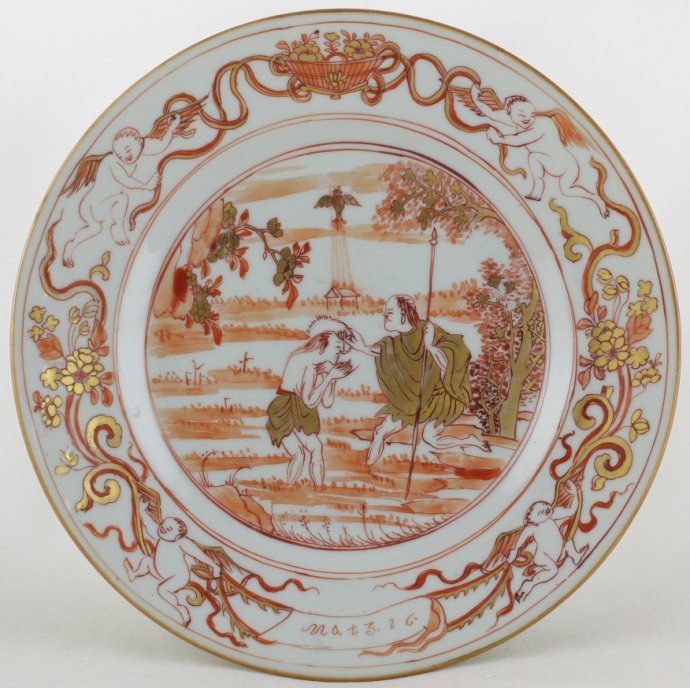
Sold Ceramics - Sold Chine de commande - Western Subjects 1680-1800 - Mythological and Religious Subjects - Religious Subjects - Page 1
Object 2012439
Dish
China
c.1735
Height 30 mm (1.18 inch), diameter of rim 216 mm (8.50 inch), diameter of footring 110 mm (4.33 inch), weight 266 grams (9.38 ounce (oz.))
Dish on footring, spreading flat, underglaze brown-edged rim (jia mangkou). Decorated in 'Red & Gold' / 'Rouge-de-fer' with iron-red and gold on the glaze with the Baptism of Jezus of Nazareth by Johm the Baptist in the river Jordan and an ascending dove (depicting the Holy Ghost) above the radiating beam of light . On the border is a design of garlands with flowers and fruit, held by putti and a flower basket with knotted tassels, at the bottom a scroll inscribed 'Mat. 3.16.', held by two putti. The reverse is undecorated.
The scene on this dish basically derived from an, as yet unidentified, print from a Bible, a Delft faience plate or another Christian publication. It was adapted by the Chinese painter by adding a rock with flowers at the left above the river. (Suebsman 2019, p.58)
The Biblical reference Mat. 3. 16.
'And Jesus, when he was baptised, went up straightway out of the water: and lo, the heavens were opened unto him, and he saw the spirit of God descending like a dove and lighting upon him: (17) And lo a voice from heaven, saying, This is my beloved Son, in whom I am well pleased'. (Howard & Ayers 1978, p.316)
The central scene utilizes no more than certain elements from the Western version of the subject - for not only are the features Chinese (to a far greater extent than is usual when a European print is copied), but the landscape too is a Chinese contrivance, and the Holy Ghost shows every sign of leaving the painter completely in the dark. It is significant that this scene, deals with baptism, which must have been the starting point for conversion in the East. It is possible that this ware was first designed for use in China and Japan, and only incidentally exported to Europe as a curiosity (and perhaps as evidence of the missionary work being done). (Howard & Ayers 1978, p.313)
The scene, also known on an earlier (1725) blue-and-white decorated dish with an added tree in the central decoration and a honeycomb diaper pattern on the sides and a fruit-laden, leafy pattern on the rim, is clearly copied from a Dutch Delftware and is held at the top by a fabulous bird - perhaps intended as a dove of peace, but painted as an eagle with the feet of a four-clawed Chinese Dragon. (Howard & Ayers 1978, p.312)
An example an earlier (1725) blue-and-white decorated dish. Reproduced from: China for the West. Chinese Porcelain and other Decorative Arts for Export illustrated from the Mottahedeh Collection, (D.S. Howard & J. Ayers, Philip Wilson Publishers for Sotheby Parke Bernet Publications, London 1978), vol. 1, cat. 306. This dish is not included in this sale/offer. (copyright in bibliographic data and images is held by the publisher or by their respective licensors: all rights reserved)
There is no doubt that the scene on this 'Red & Gold' / 'Rouge-de-fer' decorated dish is a simplification of the design shown on the earlier (1725) blue-and-white decorated dish, for the central scene is essentially the same and the putti, eagle, flowers and fruit and inscribed scroll are all present. It is entitrely in keeping with taste for the European market that the scene should be produced in rouge-de-fer and gold (a colour combination much used in armorial porcelain between 1720 an 1735). As suggested it may well be that this porcelain was intended primarely for the Christians of China and Japan. The result combines 'Chinese Imari' with Dutch Delftware (which it follows more closely tha the blue-and-whit dish( and is also reminiscent of some Arita porcelain. On other examples in the British Museum the eagle with the feet of a four-clawed Chinese Dragon at the top has been replaced with a basket filled with flowers. (Howard & Ayers 1978, p.316)
An example where basket filled with flowers at the top hs been replaced by an eagle with the feet of a four-clawed Chinese Dragon. Reproduced from: Chinese Export Porcelain. Chine de Commande from the Royal Museum of Art and History in Brussels, exhibition catalogue Hong Kong Museum of Art, (C.J.A. Jörg, The Urban Council, Hong Kong, 1989), pp.162-163, Plate 57.
This dish is not included in this sale/offer. (copyright in bibliographic data and images is held by the publisher or by their respective licensors: all rights reserved)
As to its iconography, this composition in a way resembles baptismal dishes made from silver, such as were given to children after the Christening in memory of the sacrament. Curiously only plates are known, and all of the many existing ones have a diameter of about 22 cm. (Jörg 1989/2, p.162, Suebsman 2019, p.58)
For identically decorated dishes, please see:
- China Trade Porcelain. An account of its historical background, manufacture, and decoration and a study of the Helena Woolworth McCann Collection (J.G. Phillips, Harvard University Press, Cambridge, Massachusetts, 1956), p.136, pl. 54.
- Porcelaine de le Compagnie des Indes, (M. Beurdeley, Office du Livre, Fribourg, 1962), p.207, cat. 226.
For identically decorated dishes decorated with an eagle with the feet of a four-clawed Chinese Dragon instead of a flower basket on the rim, please see:
- Chinese export porcelain. Chine de Commande, (D.F. Lunsingh Scheurleer, London 1974), cat. 237.
- China for the West. Chinese Porcelain and other Decorative Arts for Export illustrated from the Mottahedeh Collection, (D.S. Howard & J. Ayers, Philip Wilson Publishers for Sotheby Parke Bernet Publications, London 1978), vol. 1, cat. 313.
- Chinese Export Porcelain. Chine de Commande from the Royal Museum of Art and History in Brussels, exhibition catalogue Hong Kong Museum of Art, (C.J.A. Jörg, The Urban Council, Hong Kong, 1989), pp.162-163, Plate 57.
- Chinese Export Porcelain in the Reeves Center Collection at Washington and Lee University, (Th.V. Litzenburg, London 2003), p.198, cat. 198.
- Melk en Bloed. Exquisite porcelain from the Middle Kingdom, (D. Suebsman, Norden 2019), pp.58-59, cat. 18.
Condition: Professionally restored after being broken in multiple pieces.
References:
Goldsmith Phillips 1956, pl. 54
Lunsingh Scheurleer 1974, cat. 237
Howard & Ayers 1978, Plate 306 & 309
Price: Sold.
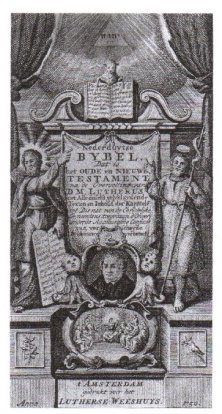
in 2002, after a tip from a private collector, Jörg first discovered that the motifs below had actually been taken from illustrations by Jan Luyken (1649-1712) published in the Lutheran Nederduytse Bijbel. In 1608 Jan Luyken made a series of twenty-four prints of New Testament scenesthat became very popular. in 1712 these were followed by eighteem prints illustrating scenes from the Old Testament. Together these prints were used, with some minor alterrations, to illustrated several editions of the Bible. The first octavo Lutheran Nederduytse Bijbel with Luyken's illustrations was printed in 1734. The title page of this and subsequent editionsincludes a portrait of Martin Luther above a cartouche showing Christ and his disciples. This title page was engraved not by Jan Luyken but by someone else, yet it is interesting to note that the pottrait and cartouche motifs also occur on Chine de commande plates. Three other motifs, the Nativity, the Crucifixion and the Resurrection also occur on Chine de commande decorated objects, only plates and parts of tea, coffe and chocolate services are known with these decorations. Since the four designs on porcelain are base on Dutch prints, the supposed Jesuit connection is no longer valid. Although there is no mention of any contemporary orders for such plates in the records of the Dutch east India Company (VOC) , it may be assumed that they were bought privately by Dutch traders, like so many other Chine de commande designs. reformed Dutch officers always carried a Bible in their ship's chest, prferably a small one to save space for other commodities. the octavo edition served their needs well, and it is likely that the prints used as models were taken from such a Bible. (Jörg 2002/4, pp.171-176)
Reference:
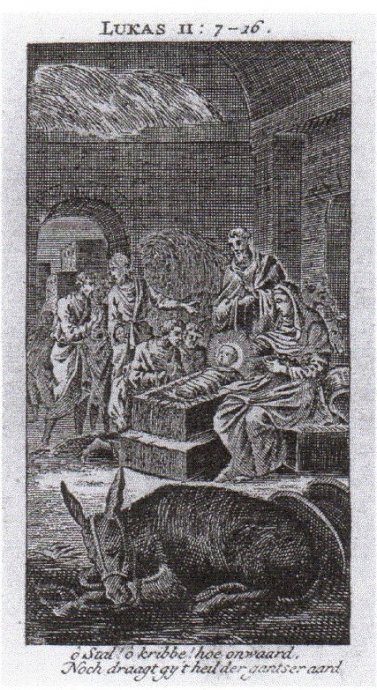
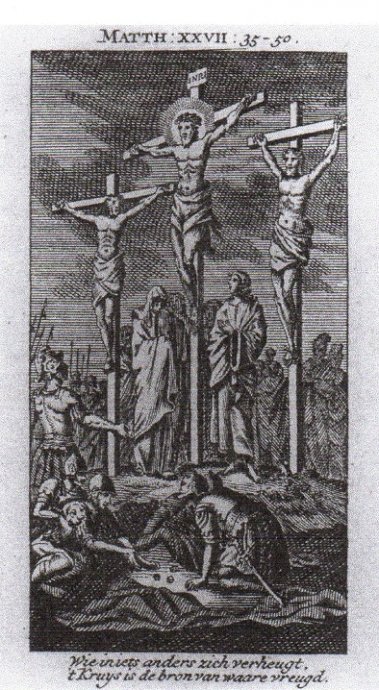
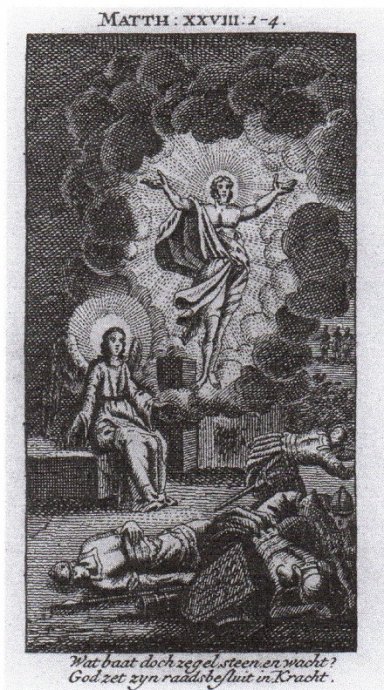

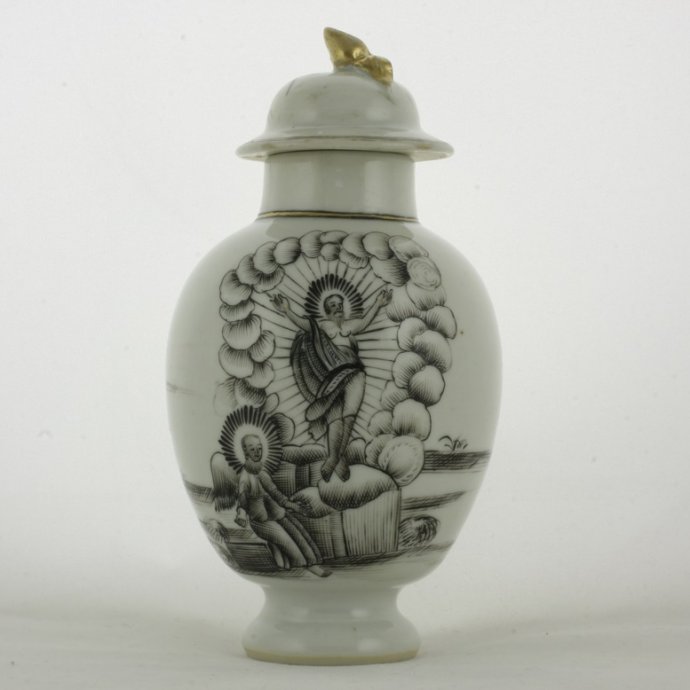
Sold Ceramics - Sold Chine de commande - Western Subjects 1680-1800 - Mythological and Religious Subjects - Religious Subjects - Page 1
Object 2010902
Tea caddy
China
1740-1750
Height with cover 142 mm (5.59 inch), diameter of rim 77 mm (3.03 inch), diameter of mouthrim 30 mm (1.18 inch), diameter of footring 38 mm (1.50 inch)
Tea caddy of ovoid form on footring, domed cover with a fruit knob. Decorated in encre de Chine and gold with a 'Resurrection' scene which shows Christ in glory rising from the tomb. He is surrounded by a background of clouds above the Angel Gabriel sitting on his left looking at the sleeping Roman soldiers, and three figures to the right of Christ in a landscape background with scattered shrubs. (Welsh 2003, pp.74-77, cat. 21)
The Resurrection design of Christ enveloped by clouds rising above a seated figure of the Angel Gabriel, with Roman soldiers collapsed in a heap.on this tea caddy directly reflects the original engraved print source, with cross-hatching rather than washes used to indicate shading. Only a few touches of gilding break the monochrome palette, which echoes the black ink that would have been used on the source print.
(Engraving reproduced from: Jörg 2002/4, pp.171-176)
For Jan Luyken's 'The Resurrection' engraving, please see:
- A Pattern of Exchange: Jan Luyken and Chine de Commande Porcelain, C.J.A. Jörg, in: Metropolitan Museum Journal, vol. 37, New York 2002, p.174.
- "Schilderagie met swarte konst", S. Bosmans in: Keramika, Jaargang 20, Nummer 1, Voorjaar 2008, p.24, afb. 4.
- Faszination des Fremden: China - Japan - Europa, (D. Antonin & D. Suebsman, Hetjens-Museum, Deutsches Keramikmuseum Düsseldorf, 2009), pp.84-85, cat. 29.
- Have a Cup of Tea. Chinese Porcelain and Tea in North-West Germany, (Exhibition catalogue, Isensee Verlag, Oldenburg, 2015), p.106,
For other objects, decorated in encre de Chine after Jan Luyken's 'The Resurrection' engraving, please see:
- China Trade Porcelain, (J. Goldsmith Phillips, Harvard University Press, Cambridge, Massachusetts 1956), p.74, plate 8.
- Chinees porselein en aardewerk, (D.F. Lunsingh Scheurleer, Bussum 1972) cat. 161
- Chinese ceramiek, catalogue Haags Gemeentemuseum, (B. Jansen, De Tijdstroom, Lochem, 1976), p.157, cat. 376.
- Collecting Chinese Eport Porcelain, (E. Gordon, New York, 1977), p.48, Plate X.
- China for the West. Chinese Porcelain and other Decorative Arts for Export illustrated from the Mottahedeh Collection, (D.S. Howard & J. Ayers, Philip Wilson Publishers for Sotheby Parke Bernet Publications, London 1978), vol. 1, pp.318-319, cat. 313.
- Chinese Export Porcelain. Chine de Commande from the Royal Museum of Art and History in Brussels, exhibition catalogue Hong Kong Museum of Art, (C.J.A. Jörg, The Urban Council, Hong Kong, 1989), pp.166-167, Plate 59.
- Imagens do Cristianismo na Porcelena da China / Christian Images in Chinese Porcelain (J. Welsh, T. Canepa, Jorge Welsh Books, London/Lisbon 2003), pp.74-77, cat. 21.
- Faszination des Fremden: China - Japan - Europa, (D. Antonin & D. Suebsman, Hetjens-Museum, Deutsches Keramikmuseum Düsseldorf, 2009), pp.84-85, cat. 29.
Condition: A restored rim of the caddy and restored frits to the rim of the cover.
References:
Goldsmith Phillips 1956, p.74, plate 8 & p.135 plate 53.
Lunsingh Scheurleer 1972, cat. 161
Lunsingh Scheurleer 1974, cat. 241
Howard & Ayers 1978, Plate 313
Hervouët 1986, cat. 11.26 & 11.27
Antonin & Suebsman 2009, cat. 29
HEmden 2015/1, pp.105-106, cat. 86
Price: Sold.
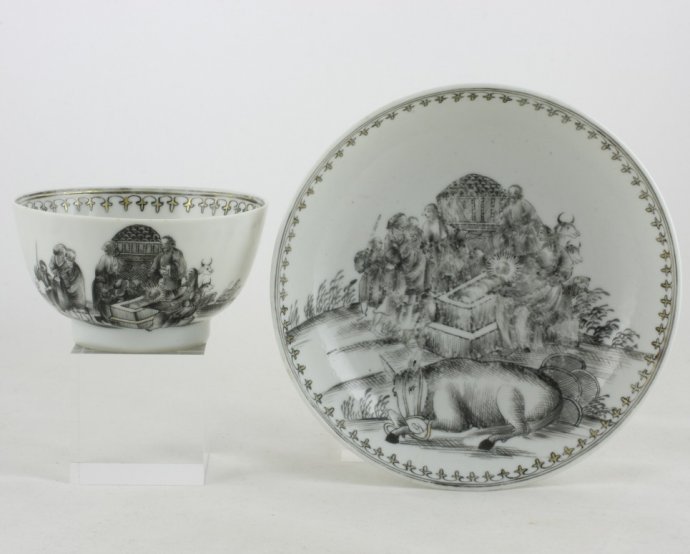
Sold Ceramics - Sold Chine de commande - Western Subjects 1680-1800 - Mythological and Religious Subjects - Religious Subjects - Page 1
Object 2011849
Teacup and saucer
China
1740-1750
Height of teacup 48 mm (1.88 inch), diameter of rim 77 mm (3.03 inch), diameter of footring 38 mm (1.49 inch), weight 50 grams (1.76 ounce (oz.))
Height of saucer 29 mm (1.14 inch), diameter of rim 120 mm (4.72 inch), diameter of footring 67 mm (2.64 inch), weight 92 grams (3.25 ounce (oz.))
Teacup and saucer on footrings with straight rims. Decorated in encre de Chine and gold with a scene of the 'Nativity' or 'Adoration of the shepherds. The virgin Mary, Joseph and the shepherds surround the baby Jesus with a gold halo inside a crib, all in a landscape setting with scattered bushes and with a donkey asleep in the foreground. On the rim a spearhead border. The teacup is decorated en suite. (Welsh 2003, p.58, cat.12)
Scenes of representations from the Bible are rather common in Chine de commande and they come in many variations mostly depicting stories from the New Testament. Although many tea wares, plates and dishes (but not apparently other dinner wares such as tureens or sauceboats) with biblical themes were produced, one may wonder if these porcelains were ever used at the tea or dinner table. Eating or drinking from Crucified Christ might well have been considered a sacrilege in the 18th century, especially in the Calvinist Netherlands. Most likely these pieces were destined for Catholic countries and used in a more or less religious context or simply had a decorative function, reminding its owner of Christian values. Formerly this type of Chine de commande, in particular pieces painted in encre de Chine, were called 'Jesuit porcelain'. However, any connection with the Jesuits in Peking or Macao or missionary activities is highly speculative and not supported by documentary evidence. Clearly Chine de commande with religious subjects was commercially ordered, just like the other types, and sold with a good profit to European customers. (Jörg 1989/2, p.160)
in 2002, after a tip from a private collector, Jörg first discovered that the motif used on this teacup and saucers had actually been taken from an illustration by Jan Luyken (1649-1712) published in the Lutheran Nederduytse Bijbel. In 1608 Jan Luyken made a series of twenty-four prints of New Testament scenes that became very popular. in 1712 these were followed by eighteen prints illustrating scenes from the Old Testament. Together these prints were used, with some minor alterations, to illustrated several editions of the Bible. The first octavo Lutheran Bible with Luyken's illustrations was printed in 1734. The title page of this and subsequent editions includes a portrait of Martin Luther above a cartouche showing Christ and his disciples. This title page was engraved not by Jan Luyken but by someone else, yet it is interesting to note that the pottrait and cartouche motifs also occur on Chine de commande plates. Three other motifs, the Nativity, the Crucifixion and the Resurrection also occur on Chine de commande decorated objects, only plates and parts of tea, coffee and chocolate services are known with these decorations. As the four designs are based on Dutch prints, the supposed Jesuit connection is no longer valid. Although there is no mention of any contemporary orders for such plates in the records of the Dutch East India Company (VOC) , it may be assumed that they were bought privately by Dutch traders, like so many other Chine de commande designs. Reformed Dutch officers always carried a Bible in their ship's chest, preferably a small one to save space for other commodities. the octavo edition served their needs well, and it is likely that the prints used as models were taken from such a Bible. (Jörg 2002/4, pp.171-176)
The Nativity design on this teacup and saucer directly reflects the original engraved print source, with cross-hatching rather than washes used to indicate shading. Only a few touches of gilding break the monochrome palette, which echoes the black ink that would have been used on the source print.
(Reproduced from: Jörg 2002/4, pp.171-176)
For Jan Luyken's Nativity's engraving, please see:
- A Pattern of Exchange: Jan Luyken and Chine de Commande Porcelain, C.J.A. Jörg, in: Metropolitan Museum Journal, vol. 37, New York 2002, p.172.
- "Schilderagie met swarte konst", S. Bosmans in: Keramika, Jaargang 20, Nummer 1, Voorjaar 2008, p.24, afb. 3.
- Faszination des Fremden: China - Japan - Europa, (D. Antonin & D. Suebsman, Hetjens-Museum, Deutsches Keramikmuseum Düsseldorf, 2009), pp.80-81, cat. 27.
- Have a Cup of Tea. Chinese Porcelain and Tea in North-West Germany, (Exhibition catalogue, Isensee Verlag, Oldenburg, 2015), p.106,
For other objects, decorated in encre de Chine and gilt after Jan Luyken's Nativity's engraving, please see:
- Porcelaine de le Compagnie des Indes, (M. Beurdeley, Fribourg 1962), cat. 225.
- Chinese export porcelain. Chine de Commande, (D.F. Lunsingh Scheurleer, London 1974), cat. 300.
- China for the West. Chinese Porcelain and other Decorative Arts for Export illustrated from the Mottahedeh Collection, (D.S. Howard & J. Ayers, Philip Wilson Publishers for Sotheby Parke Bernet Publications, London 1978), vol. 1, p.312, cat. 305.
- Oriental Export Market Porcelain and its influence on European Wares, (G.A. Godden, Granada Publishers Limited, London/New York/Sydney/Toronto/Johannesburg/Auckland, 1979), p.223, cat. 138.
- Christie's pictorial history of Chinese ceramics, (A. du Boulay, Phaidon-Christie's, Oxford 1984), p.273, cat. 14.
- La porcelaine des Compagnies des Indes a décor Occidental, (F. & N. Hervouët & Y. Bruneau, Flammarion - Pere Castor, Paris 1986), p.263, cat. 11.12.
- Chinese Export Porcelain in the Reeves Center Collection at Washington and Lee University, (Th. V. Litzenburg, London 2003), p.203, cat. 203.
- Imagens do Cristianismo na Porcelena da China / Christian Images in Chinese Porcelain (J. Welsh, T. Canepa, Jorge Welsh Books, London/Lisbon 2003), pp.56-63, cat. 12.
- "Schilderagie met swarte konst", S. Bosmans in: Keramika, Jaargang 20, Nummer 1, Voorjaar 2008, p.24, afb. 1.
- Faszination des Fremden: China - Japan - Europa, (D. Antonin & D. Suebsman, Hetjens-Museum, Deutsches Keramikmuseum Düsseldorf, 2009), pp.80-81, cat. 27.
- Have a Cup of Tea. Chinese Porcelain and Tea in North-West Germany, (Exhibition catalogue, Isensee Verlag, Oldenburg, 2015), p.105, cat. 86,
For other polychrome decorated objects after Jan Luyken's Nativity's engraving, please see:
- Collecting Chinese Export Porcelain, (E. Gordon, Universe Books, New York, 1977), plate. 10.
- Made in China. Porcelain from the Leo and Doris Hodroff Collection at Winterthur (R.W. Fuchs II & D.S. Howard, Winterthur 2005), p.66, cat. 28.
Condition teacup: A restored (re-stuck) piece, and a hairline to the rim.
Condition saucer: Wear to the decoration and four small hairlines to the rim.
References:
Lunsingh Scheurleer 1974, cat. 300
Howard & Ayers 1978, vol. 1, cat. 305
Bosmans 2008, p.24, afb. 1 & 3
Emden 2015/1, pp.105-106, cat. 86
Price: Sold.


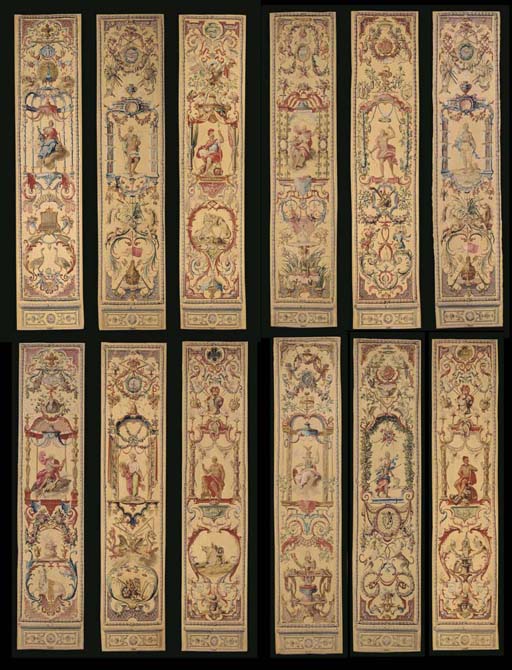
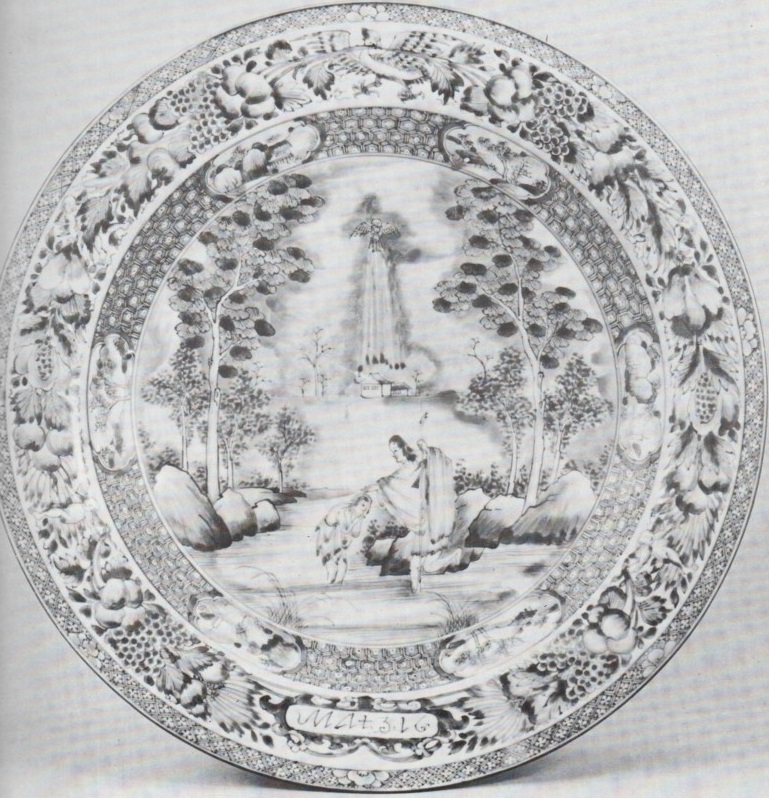
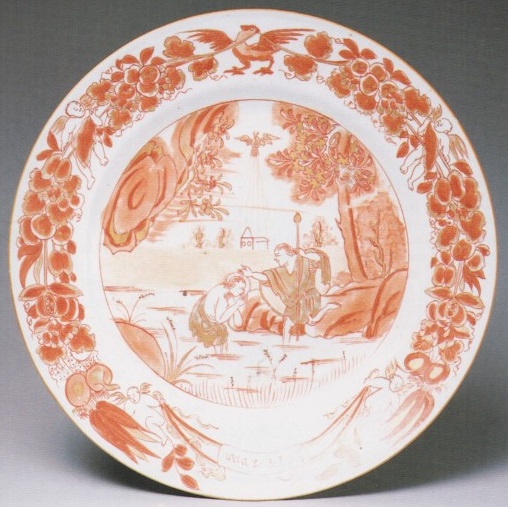
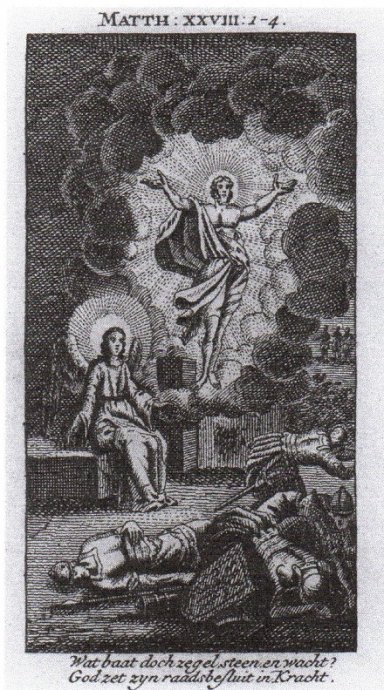
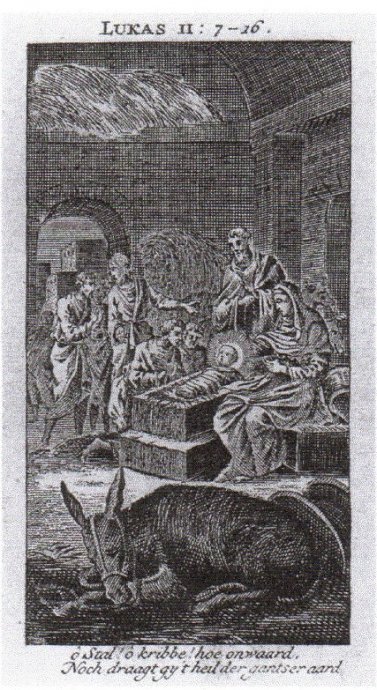
 create websites
create websites